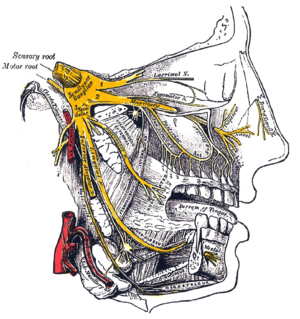Cold-stimulus headache facts for kids
Quick facts for kids Cold-stimulus headache |
|
|---|---|
| Synonyms | Ice-cream headache, brain freeze |
 |
|
| A young girl hastily consuming ice cream, a common cause of cold-stimulus headaches, which are aptly called "brain freezes" or "ice-cream headaches". | |
| Duration | 20 seconds to 2 minutes depending on severity |
| Causes | Quick consumption of cold foods and beverages or prolonged oral exposure to cold stimuli |
| Treatment | Removal of the cold stimulus from the oral cavity and thrusting the tongue towards the tip of the nose or roof of the mouth to relieve pain. Drinking warm water can also ease pain. |
A cold-stimulus headache is what doctors call that sudden, sharp pain you feel in your head when you eat or drink something really cold too fast. You probably know it better as an ice-cream headache or brain freeze. It often happens when you quickly enjoy cold treats like ice cream, popsicles, or snow cones.
This quick pain starts when something cold touches the roof of your mouth. Scientists believe it's because your nerves react, causing blood vessels to quickly get smaller and then bigger. This sends a pain signal from your mouth to your head. How fast you eat cold foods can make a difference. You can also get a brain freeze if your head is suddenly exposed to very cold temperatures, like diving into cold water. Even some animals, like Cats, can get a similar reaction!
Contents
What We Call It
The name ice-cream headache has been around for a long time. It was first written down in a journal entry in 1937. The term brain freeze was first used in print in 1991. Did you know that the company 7-Eleven has actually trademarked the term "brain freeze"?
Why Does Brain Freeze Happen?
A cold-stimulus headache happens because the tiny blood vessels, called capillaries, in your sinuses (air-filled spaces in your skull) cool down very quickly and then warm up fast. This causes them to first get smaller (constrict) and then suddenly get much bigger (dilate). It's a bit like how your face gets "flushed" after being outside on a cold day. Your blood vessels react to the cold by constricting, then they expand a lot as they warm up.
In the roof of your mouth, this sudden expansion of blood vessels is felt by tiny pain sensors. These sensors send signals to your brain through a major nerve in your face called the trigeminal nerve. Because this nerve also handles pain from your forehead, your brain sometimes thinks the pain is coming from your forehead, even though it started in your mouth. This is called "referred pain".
Brain freeze pain usually lasts only a few seconds, but it can sometimes go on for a couple of minutes. Some research suggests that the way your blood vessels and nerves react during a brain freeze is similar to what happens during a migraine headache.
You can get a cold-stimulus headache whether the weather is hot or cold. It all depends on the temperature of the food or drink you are having.

Another Idea: Blood Flow to the Brain
Another idea about why brain freeze happens involves something called the anterior cerebral artery. This is a blood vessel that brings oxygen-rich blood to a large part of the front of your brain. When you get a brain freeze, there might be a sudden increase in blood flow to your brain through this artery. This extra blood and the artery getting bigger could be what causes the pain.
When this artery then quickly gets smaller again, the pain goes away. This quick expansion and then shrinking of the blood vessel might be a way for your brain to protect itself. It's like your brain is trying to control the amount of blood flowing in. If too much blood flows in too quickly, it could raise the pressure inside your skull and cause pain. So, the blood vessel contracts to lower the pressure before it gets too high.
What Scientists Have Found
Brain freeze is so common that scientists have even studied it! A study by Maya Kaczorowski showed that more people got a headache if they ate ice cream very quickly (in less than 5 seconds) compared to those who ate it slowly (taking more than 30 seconds). About 27% of fast eaters got a headache, while only 12% of slow eaters did.
Another study by Nigel Bird, Anne MacGregor, and Marcia I. Wilkinson found that 17% of people who already got migraines and 46% of students got a headache after eating ice cream or having something cold touch the roof of their mouth.
See also
 In Spanish: Cefalea por estímulos fríos para niños
In Spanish: Cefalea por estímulos fríos para niños

